Assignment on Counselling: Integration of Psychotherapy Theories
VerifiedAdded on 2020/02/12
|5
|749
|111
Homework Assignment
AI Summary
This assignment provides an introduction to counselling, focusing on the integration of various approaches to psychotherapy. It explores the pathways to integration, including subjective, intersubjective, objective, and interobjective approaches. The assignment defines five key principles of integrative psychotherapy: multi-theoretical, multidimensional, strategy-based, relational, and intentional. It also discusses the issues that can arise during theoretical integration, highlighting challenges with integrating certain theories due to differing philosophies and concepts. Finally, the assignment emphasizes the importance of integration theory's skills and concepts in aiding counsellors, mentioning common factors like emotional release and therapist-client rapport that facilitate effective case resolution. The assignment references key literature to support its claims.
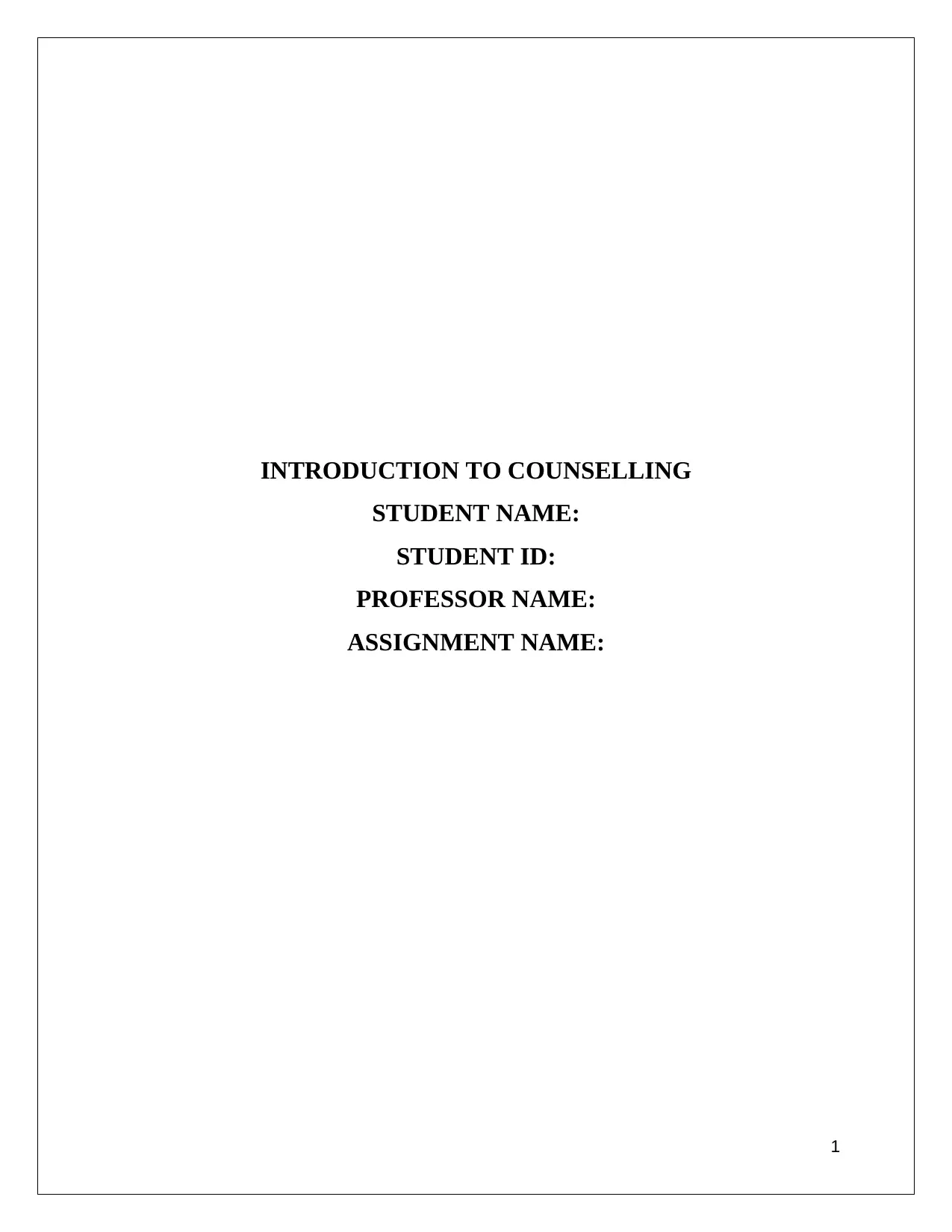
INTRODUCTION TO COUNSELLING
STUDENT NAME:
STUDENT ID:
PROFESSOR NAME:
ASSIGNMENT NAME:
1
STUDENT NAME:
STUDENT ID:
PROFESSOR NAME:
ASSIGNMENT NAME:
1
Paraphrase This Document
Need a fresh take? Get an instant paraphrase of this document with our AI Paraphraser
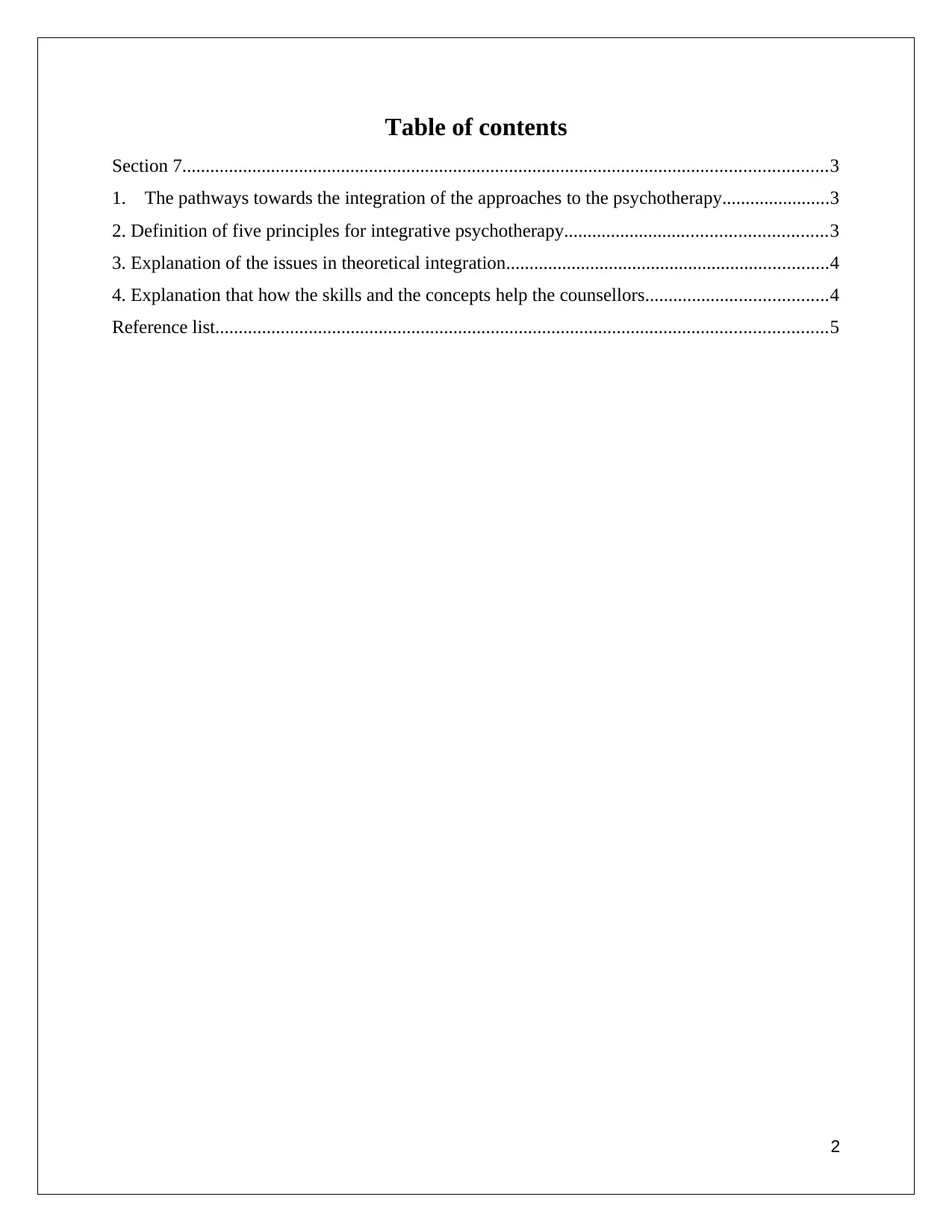
Table of contents
Section 7..........................................................................................................................................3
1. The pathways towards the integration of the approaches to the psychotherapy.......................3
2. Definition of five principles for integrative psychotherapy........................................................3
3. Explanation of the issues in theoretical integration.....................................................................4
4. Explanation that how the skills and the concepts help the counsellors.......................................4
Reference list...................................................................................................................................5
2
Section 7..........................................................................................................................................3
1. The pathways towards the integration of the approaches to the psychotherapy.......................3
2. Definition of five principles for integrative psychotherapy........................................................3
3. Explanation of the issues in theoretical integration.....................................................................4
4. Explanation that how the skills and the concepts help the counsellors.......................................4
Reference list...................................................................................................................................5
2
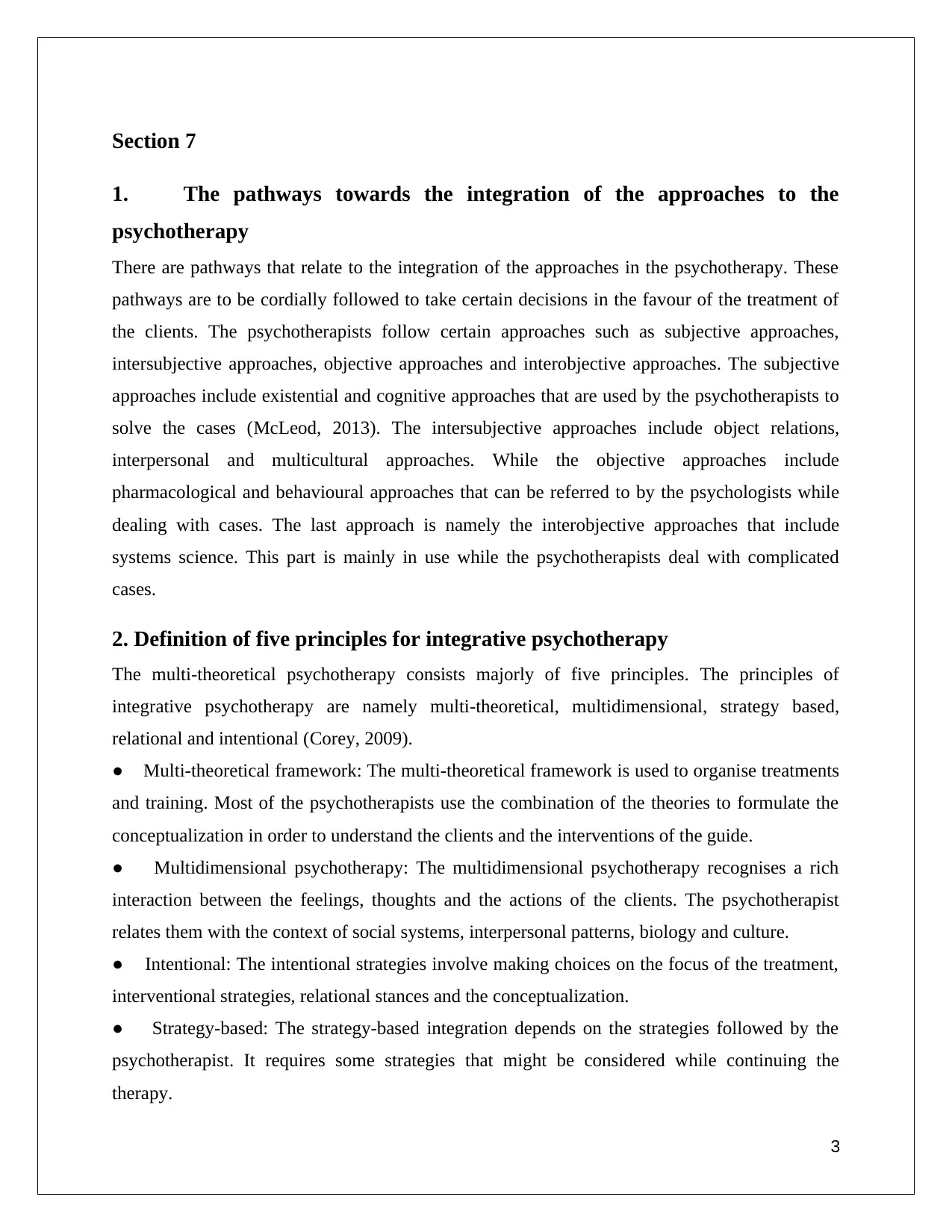
Section 7
1. The pathways towards the integration of the approaches to the
psychotherapy
There are pathways that relate to the integration of the approaches in the psychotherapy. These
pathways are to be cordially followed to take certain decisions in the favour of the treatment of
the clients. The psychotherapists follow certain approaches such as subjective approaches,
intersubjective approaches, objective approaches and interobjective approaches. The subjective
approaches include existential and cognitive approaches that are used by the psychotherapists to
solve the cases (McLeod, 2013). The intersubjective approaches include object relations,
interpersonal and multicultural approaches. While the objective approaches include
pharmacological and behavioural approaches that can be referred to by the psychologists while
dealing with cases. The last approach is namely the interobjective approaches that include
systems science. This part is mainly in use while the psychotherapists deal with complicated
cases.
2. Definition of five principles for integrative psychotherapy
The multi-theoretical psychotherapy consists majorly of five principles. The principles of
integrative psychotherapy are namely multi-theoretical, multidimensional, strategy based,
relational and intentional (Corey, 2009).
● Multi-theoretical framework: The multi-theoretical framework is used to organise treatments
and training. Most of the psychotherapists use the combination of the theories to formulate the
conceptualization in order to understand the clients and the interventions of the guide.
● Multidimensional psychotherapy: The multidimensional psychotherapy recognises a rich
interaction between the feelings, thoughts and the actions of the clients. The psychotherapist
relates them with the context of social systems, interpersonal patterns, biology and culture.
● Intentional: The intentional strategies involve making choices on the focus of the treatment,
interventional strategies, relational stances and the conceptualization.
● Strategy-based: The strategy-based integration depends on the strategies followed by the
psychotherapist. It requires some strategies that might be considered while continuing the
therapy.
3
1. The pathways towards the integration of the approaches to the
psychotherapy
There are pathways that relate to the integration of the approaches in the psychotherapy. These
pathways are to be cordially followed to take certain decisions in the favour of the treatment of
the clients. The psychotherapists follow certain approaches such as subjective approaches,
intersubjective approaches, objective approaches and interobjective approaches. The subjective
approaches include existential and cognitive approaches that are used by the psychotherapists to
solve the cases (McLeod, 2013). The intersubjective approaches include object relations,
interpersonal and multicultural approaches. While the objective approaches include
pharmacological and behavioural approaches that can be referred to by the psychologists while
dealing with cases. The last approach is namely the interobjective approaches that include
systems science. This part is mainly in use while the psychotherapists deal with complicated
cases.
2. Definition of five principles for integrative psychotherapy
The multi-theoretical psychotherapy consists majorly of five principles. The principles of
integrative psychotherapy are namely multi-theoretical, multidimensional, strategy based,
relational and intentional (Corey, 2009).
● Multi-theoretical framework: The multi-theoretical framework is used to organise treatments
and training. Most of the psychotherapists use the combination of the theories to formulate the
conceptualization in order to understand the clients and the interventions of the guide.
● Multidimensional psychotherapy: The multidimensional psychotherapy recognises a rich
interaction between the feelings, thoughts and the actions of the clients. The psychotherapist
relates them with the context of social systems, interpersonal patterns, biology and culture.
● Intentional: The intentional strategies involve making choices on the focus of the treatment,
interventional strategies, relational stances and the conceptualization.
● Strategy-based: The strategy-based integration depends on the strategies followed by the
psychotherapist. It requires some strategies that might be considered while continuing the
therapy.
3
⊘ This is a preview!⊘
Do you want full access?
Subscribe today to unlock all pages.

Trusted by 1+ million students worldwide
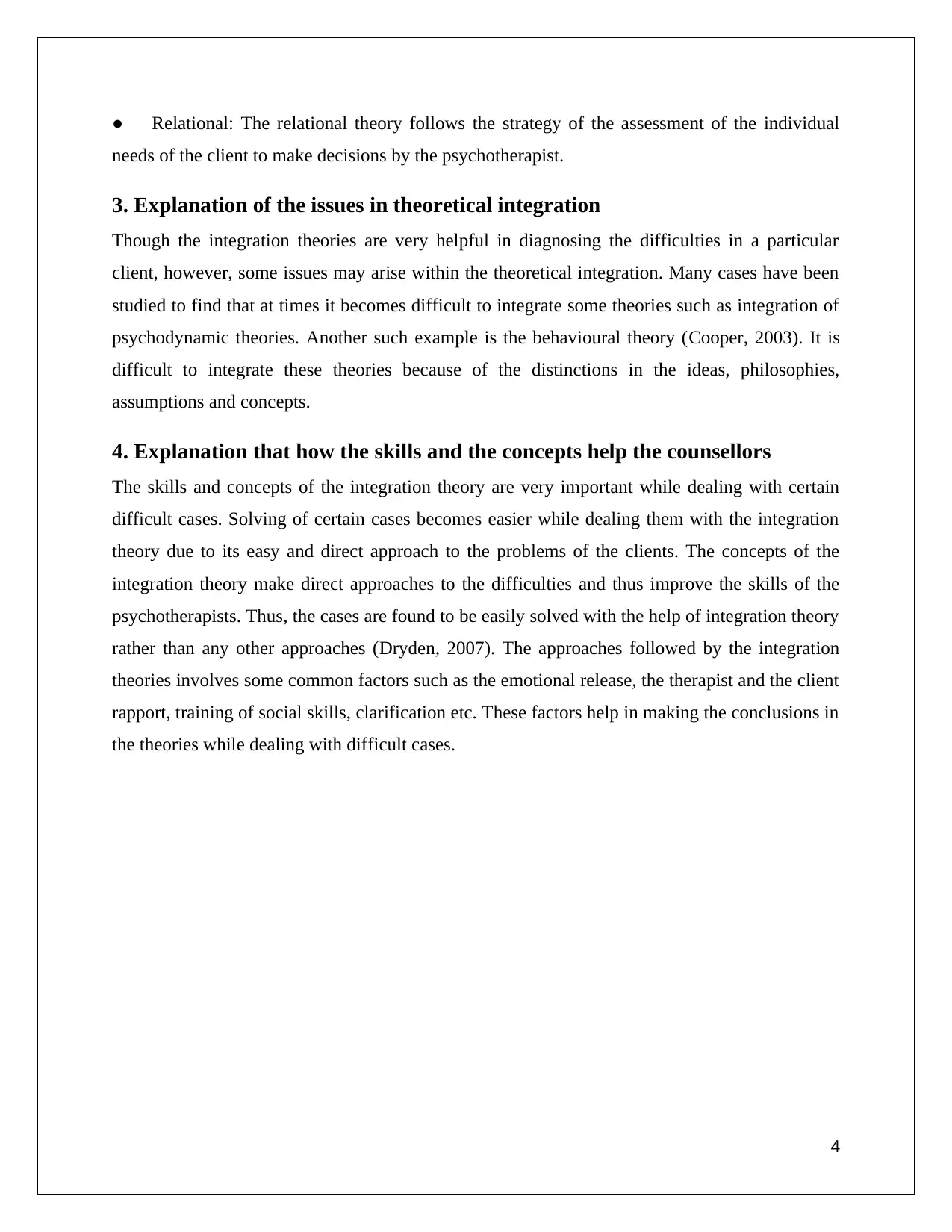
● Relational: The relational theory follows the strategy of the assessment of the individual
needs of the client to make decisions by the psychotherapist.
3. Explanation of the issues in theoretical integration
Though the integration theories are very helpful in diagnosing the difficulties in a particular
client, however, some issues may arise within the theoretical integration. Many cases have been
studied to find that at times it becomes difficult to integrate some theories such as integration of
psychodynamic theories. Another such example is the behavioural theory (Cooper, 2003). It is
difficult to integrate these theories because of the distinctions in the ideas, philosophies,
assumptions and concepts.
4. Explanation that how the skills and the concepts help the counsellors
The skills and concepts of the integration theory are very important while dealing with certain
difficult cases. Solving of certain cases becomes easier while dealing them with the integration
theory due to its easy and direct approach to the problems of the clients. The concepts of the
integration theory make direct approaches to the difficulties and thus improve the skills of the
psychotherapists. Thus, the cases are found to be easily solved with the help of integration theory
rather than any other approaches (Dryden, 2007). The approaches followed by the integration
theories involves some common factors such as the emotional release, the therapist and the client
rapport, training of social skills, clarification etc. These factors help in making the conclusions in
the theories while dealing with difficult cases.
4
needs of the client to make decisions by the psychotherapist.
3. Explanation of the issues in theoretical integration
Though the integration theories are very helpful in diagnosing the difficulties in a particular
client, however, some issues may arise within the theoretical integration. Many cases have been
studied to find that at times it becomes difficult to integrate some theories such as integration of
psychodynamic theories. Another such example is the behavioural theory (Cooper, 2003). It is
difficult to integrate these theories because of the distinctions in the ideas, philosophies,
assumptions and concepts.
4. Explanation that how the skills and the concepts help the counsellors
The skills and concepts of the integration theory are very important while dealing with certain
difficult cases. Solving of certain cases becomes easier while dealing them with the integration
theory due to its easy and direct approach to the problems of the clients. The concepts of the
integration theory make direct approaches to the difficulties and thus improve the skills of the
psychotherapists. Thus, the cases are found to be easily solved with the help of integration theory
rather than any other approaches (Dryden, 2007). The approaches followed by the integration
theories involves some common factors such as the emotional release, the therapist and the client
rapport, training of social skills, clarification etc. These factors help in making the conclusions in
the theories while dealing with difficult cases.
4
Paraphrase This Document
Need a fresh take? Get an instant paraphrase of this document with our AI Paraphraser
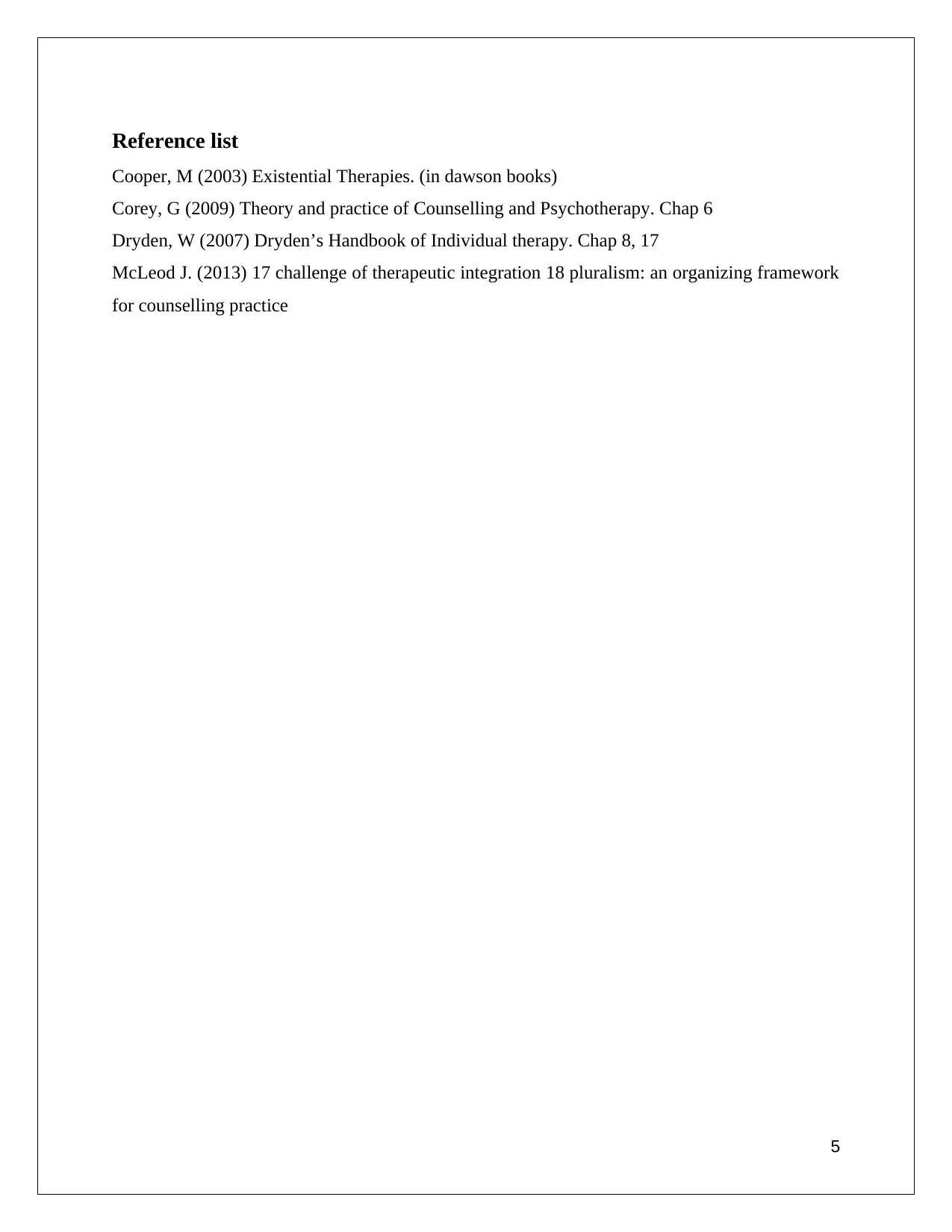
Reference list
Cooper, M (2003) Existential Therapies. (in dawson books)
Corey, G (2009) Theory and practice of Counselling and Psychotherapy. Chap 6
Dryden, W (2007) Dryden’s Handbook of Individual therapy. Chap 8, 17
McLeod J. (2013) 17 challenge of therapeutic integration 18 pluralism: an organizing framework
for counselling practice
5
Cooper, M (2003) Existential Therapies. (in dawson books)
Corey, G (2009) Theory and practice of Counselling and Psychotherapy. Chap 6
Dryden, W (2007) Dryden’s Handbook of Individual therapy. Chap 8, 17
McLeod J. (2013) 17 challenge of therapeutic integration 18 pluralism: an organizing framework
for counselling practice
5
1 out of 5
Related Documents
Your All-in-One AI-Powered Toolkit for Academic Success.
+13062052269
info@desklib.com
Available 24*7 on WhatsApp / Email
![[object Object]](/_next/static/media/star-bottom.7253800d.svg)
Unlock your academic potential
Copyright © 2020–2025 A2Z Services. All Rights Reserved. Developed and managed by ZUCOL.



